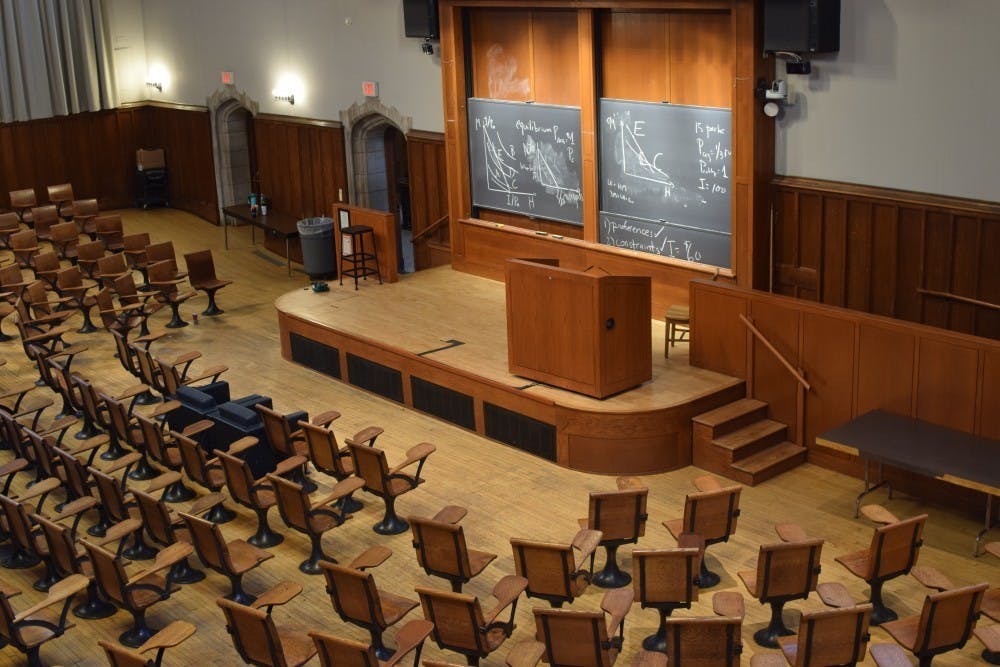In a memo sent to all faculty members on Tuesday, Dean of the College Jill Dolan announced University support for two formats for undergraduate courses — hybrid or online — for the spring 2021 semester.
While President Christopher Eisgruber ’83 previously announced the University hoped to bring “significantly more” undergraduates to campus this spring, a decision about who may reside on campus is not expected until the first week of December.
The current guidelines for hybrid instruction, which are subject to change, allow for some students to sit physically in classrooms, with others joining live instruction via Zoom. Faculty members will also be permitted to introduce “in-person or hybrid elements” to otherwise online courses — including socially distanced office hours or optional in-person precepts.
“We’re happy to assist your thinking about creative ways to take advantage of some students’ potential presence on campus to inform your choice of teaching format,” Dolan wrote.
Even so, all instructors teaching hybrid courses must be prepared to switch to an “entirely virtual environment” should public health guidance deem in-person teaching unsafe at any point in time.
The University has made approximately 65 classrooms available that meet requirements for “safe ventilation and student capacity,” in accordance with Office of Environmental Health and Safety guidelines.
“These classrooms have been reconfigured accordingly,” Dolan wrote. “Furniture has been removed or re-arranged for proper social distancing and seats have been clearly marked to indicate where people can sit.”

Dolan added that classrooms will be “scheduled in alternating blocks to allow Building Services to clean them before and after each use” and all individuals in classrooms will be required to wear masks and maintain social distancing.
Inventory of classrooms might also shift, according to the memo, depending on potential adjustments to ventilation. Under the prescribed guidelines, classrooms will be capped at approximately ten percent of their usual capacity.
McCosh 50 — the University’s largest available classroom — for example, will be able to accommodate no more than 42 occupants, according to the memo. Similarly, classrooms that might typically hold 250 will only be able to accommodate 25 students and one that normally holds 30 will accommodate at most four.
“If you’re teaching a lecture that includes more structured opportunities for student questions, hybrid teaching might work well,” Dolan wrote. “Teaching a hybrid lab course is more complicated and would require careful coordination and consultation with the Office of the Dean for Research and individual departments.”

The Office of Information Technology, Instructional Support Services, and the McGraw Center for Teaching and Learning are currently “testing and purchasing technology that will best support hybrid teaching,” with particular attention paid to “sound quality and equipment reliability and ease of use.”
Dolan confirmed that faculty will continue to use Zoom in order to reach students learning virtually, but added that the University recommends employing an Assistant in Instruction (AI) or Undergraduate Course Assistant to “support the in-class logistics required for successful hybrid instruction.”
The memo emphasized that the choice of format is up to the instructors themselves, while reminding faculty that “international students studying remotely in other time zones may continue to find it difficult to participate in synchronous activities and will appreciate access to recorded course materials.”
Dolan asked instructors to complete a Google Form by Nov. 23 as an “early indication of … interest, rather than a formal classroom request” in order to begin the iterative planning process. The form asks instructors which courses they plan to teach using a hybrid model, which aspects of the course they would like to conduct in person, and how many students they expect to enroll.
The memo added that all in-person instruction will be hybrid by necessity, as “some students may be required to quarantine during the term” and “it’s difficult to predict if all students in your course will be on campus, even if they are invited back.”








